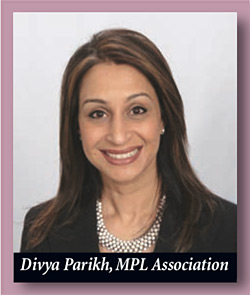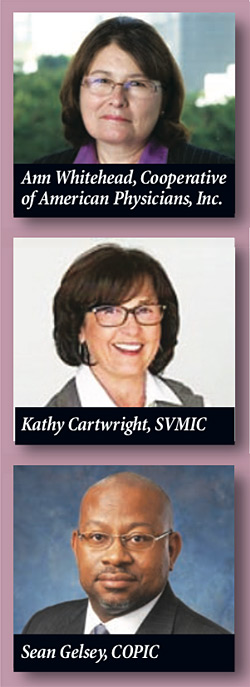During the next 35 years, the DSP evolved into a sophisticated data analytics tool that provides member companies with valuable intelligence on a growing list of MPL claims, verdicts, and related data across medical specialties.
“What’s exciting is that over the past three years we’ve expanded the capability to capture novel areas of MPL risk,” said Divya Parikh, vice president of research and education for the MPL Association. “We see more advanced healthcare professionals, robotic surgery, and telehealth. Additionally, we are capturing many subspecialties, hospital-based information, and comorbidities,” she continued. An evolving database allows MPL stakeholders to analyze data in critical areas, ultimately providing quantitative support to guide decision-making, she noted.
The DSP reflects the MPL Association’s mission of supporting, educating, and advocating for MPL insurers, providers, and other stakeholders across America and around the world. However, as data assumed a more and more vital role in decision-making in MPL and other areas, the vision of the DSP founders has been more than validated. As the largest independent ongoing MPL claims database, the DSP continues to provide valuable intelligence to a wide variety of MPL stakeholders.
Benefits of the DSP
 MPL Association members agree. “The DSP not only provides a big picture view related to claims, but it also offers insight into high-risk specialties, specific risk issues, and procedures, which allow member companies to direct their efforts towards reducing financial risk and improving patient safety,” said Ann Whitehead, vice president for risk management and patient safety with Cooperative of American Physicians, Inc, an MPL mutual in Los Angeles, California. “The DSP also offers visibility into data trends and emerging risk, which is critically important.”
MPL Association members agree. “The DSP not only provides a big picture view related to claims, but it also offers insight into high-risk specialties, specific risk issues, and procedures, which allow member companies to direct their efforts towards reducing financial risk and improving patient safety,” said Ann Whitehead, vice president for risk management and patient safety with Cooperative of American Physicians, Inc, an MPL mutual in Los Angeles, California. “The DSP also offers visibility into data trends and emerging risk, which is critically important.”
Whitehead, who is the current chair of the MPL Association’s Data Sharing Advisory Committee, commented that the DSP’s real-time information provides very useful material that the Cooperative of American Physicians compares with their own data and uses to educate their members. In comparison to many other property/casualty insurance sectors, MPL data is relatively sparse because of the nature of MPL claims. Not only do many specialties and subspecialties not generate many claims, but the circumstances surrounding claims can differ widely, making it difficult to draw credible conclusions.
However, employing DSP data—and other MPL databases—makes it far easier to place individual carrier data in context and determine whether data points are an anomaly or a trend. Kathy Cartwright, assistant vice president of risk analytics at SVMIC, an MPL mutual insurer in Brentwood, Tennessee, identifies this aspect of the DSP as highly beneficial. “The beauty of the bigger numbers that we get from the DSP means that we get a much better idea of how big a problem something is or whether it is a problem or not,” she said. “Without the DSP—and conversation with others involved in the project— we’d have a much harder time understanding whether what we’re seeing is an isolated event, something that is trending in our area, or something that is trending nationally.”
Identifying trends in data is critical to MPL stakeholders because it creates the potential for improved risk assessment and enhanced patient safety.
 The sharing aspect of the DSP differentiates it from other data collection initiatives. The DSP cultivates a collaborative approach to sharing data for actionable insights without compromising confidentiality or revealing proprietary information. “The DSP demonstrates the collaborative nature of the MPL community and what we can accomplish when we work together,” said Parikh.
The sharing aspect of the DSP differentiates it from other data collection initiatives. The DSP cultivates a collaborative approach to sharing data for actionable insights without compromising confidentiality or revealing proprietary information. “The DSP demonstrates the collaborative nature of the MPL community and what we can accomplish when we work together,” said Parikh.
Sean Gelsey, senior vice president of claims and strategic partnerships at COPIC, an MPL insurer based in Denver, Colorado, believes that the DSP offers a baseline data point for national MPL data that provides a context for what’s going on outside of an MPL insurer’s individual jurisdictions. “The DSP and the Data Sharing Advisory Committee also offer opportunities to network and learn from other companies about best practices,” he said. “They show the MPL Association’s commitment to doing what is right for the MPL community at large.”
Where the DSP goes from here
Far from resting on its laurels, the DSP continues to grow and evolve. Through the pandemic, and after the pandemic ends, whenever that may be, the DSP will pursue its mission of providing a tool that supports evidence-based decision-making.
“Healthcare delivery is always evolving, which means that medical professional liability continues to change to keep pace,” commented Parikh. “I commend all the insurers within the Association for being very proactive about addressing risks. This unprecedented year really showcases the power of participating in a national database. Through the activities of the COVID Claims Litigation group, the Association is creating new taxonomy to capture pandemic-related claims information. Being plugged into a database ahead of a crisis like this makes the process an easy lift.”
While the pandemic has certainly impacted the MPL industry in many ways, it has also sharpened focus on what the MPL Association does best—knowledge sharing. “The DSP is much more than capturing claims data; it’s knowledge sharing even when there are no claims to review,” Parikh said. “It’s bringing communities of MPL experts together to be collaborative and proactive in mitigating all types of risk to optimize the healthcare environment.”
Going forward, the question is how the DSP and the Association can facilitate both medicine and medical professional liability to advance the standards of care, patient safety, and risk management, Parikh continued. “Working together, there’s nothing we can’t accomplish,” she said.